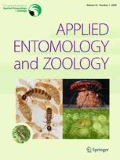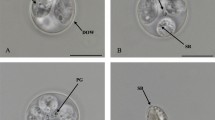Abstract
We identified mermithid nematodes infecting a post-hibernating Japanese bumblebee (Bombus pseudobaicalensis Vogt) queen in Nemuro, Hokkaido, Japan. The infected queen did not lay eggs or feed on pollen during laboratory rearing. In addition, the queen usually crawled under the straw set in the rearing box, which differed from the typical behavior of a normal queen. Intra-abdominal observation revealed that, compared with the ovaries of a normal queen, those of the infected queen were undeveloped. Infection by mermithid nematodes may result in the sterilization of the bumblebee queen. The molecular phylogenetic analysis revealed that the mermithid species infecting the Japanese bumblebee queen differed from the Pheromermis species reported as a parasite of Hymenopteran insects, and that they were closely related to mermithid nematodes found in spiders and Ovomermis sinensis Chen, a parasite of the tobacco budworm larva Helicoverpa armigera Hübner. These findings constitute the first report of mermithid nematodes infecting Japanese bumblebee.




Similar content being viewed by others
References
Bedding RA (1984) Nematode parasites of Hymenoptera. In: Nickle WR (ed) Plant and insect nematodes. Dekker, New York, pp 755–795
Dong L, Sanad M, Wang Y, Xu Y, Shamseldean MSM, Gaugler R (2014) Mating clusters in the mosquito parasitic nematode, Strelkovimermis spiculatus. J Invertebr Pathol 117:19–25
Guindon S, Dufayard JF, Lefort V, Anisimova M, Hordijk W, Gascuel O (2010) New algorithms and methods to estimate maximum-likelihood phylogenies: assessing the performance of PhyML 3.0. Syst Biol 59:307–321
Hadziavdic K, Lekang K, Lanzen A, Jonassen I, Thompson EM, Troedsson C (2014) Characterization of the 18S rRNA gene for designing universal eukaryote specific primers. PLoS ONE 9:e87624
Holterman M, Rybarczyk K, van den Elsen S, van Megen H, Mooyman P, Santiago RP, Bongers T, Bakker J, Helder J (2008) A ribosomal DNA-based framework for the detection and quantification of stress-sensitive nematode families in terrestrial habitats. Mol Ecol Resour 8:23–34
Kadoya ZE, Ishii SH (2015) Host manipulation of bumble bee queens by Sphaerularia nematodes indirectly affects foraging of non-host workers. Ecology 96:1361–1370
Kaiser H (1991) Terrestrial and semiterrestrial mermithidae. In: Nickle WR (ed) Manual of agricultural nematology. Dekker, New York, pp 899–965
Kosaka H, Sayama K, Kanzaki N, Makino S, Okabe K (2012) Parasites of the introduced bumblebee, Bombus terrestris, naturalized in Hokkaido, northern Japan. Chikyu-kankyo 17(2):135–141 (in Japanese)
Kubo R, Ono M (2011) Function of ecological volatiles in pollination symbiosis—with special reference to relation with social bees and wasps. Regul Plant Growth Dev 46(1):51–57 (in Japanese with English summary)
Li Q, Sun Y, Wang G, Liu X (2009) Effects of the mermithid nematode Ovomermis sinensis on the hemocytes of its host Helicoverpa armigera. J Insect Physiol 55(1):47–50
Mcinnes DA, Tschinkel WR (1996) Mermithid nematode parasitism of Solenopsis ants (Hymenoptera: Formicidae) of Northern Florida. Ann Entomol Soc Am 89:231–237
Pernin A, Zanzani S, Mereghetti V, Manfredi MT, Lozzia G, Montagna M (2015) First record of a mermithid nematode in the leaf beetle Galeruca laticollis (Coleoptera: Chrysomelidae). Russ J Nematol 23:73–75
Poinar GO (1975) Entomogenous nematodes. A manual and host list of insect-nematode associations. Brill, Leiden
Poinar GO, Lane RS, Thomas GM (1976) Biology and redescription of Pheromermis pachysoma (V. Linstow) n. gen., n. comb. (Nematoda: Mermithidae), a parasite of yellowjackets (Hymenoptera: Vespidae). Nematrogica 22:360–370
Poinar GO, Porter SD, Tang S, Hyman BC (2007) Allomermis solenopsi n. sp. (Nematoda: Mermithidae) parasitising the fire ant Solenopsis invicta Buren (Hymenoptera: Formicidae) in Argentina. Syst Parasitol 68:115–128
Sayama K, Kosaka H, Makino S (2013) Release of juvenile nematodes at hibernation sites by overwintered queens of the hornet Vespa simillima. Insect Soc 60:383–388
Tamura K, Peterson D, Peterson N, Stecher G, Nei M, Kumar S (2011) MEGA5: molecular evolutionary genetics analysis using maximum likelihood, evolutionary distance, and maximum parsimony methods. Mol Biol Evol 28:2731–2739
Thompson JD, Higgins DG, Gibson TJ (1994) CLUSTAL W: improving the sensitivity of progressive multiple sequence alignment through sequence weighting, position-specific gap penalties and weight matrix choice. Nucleic Acids Res 22:4673–4680
Umbers KDL, Byatt LJ, Hill NJ, Bartolini RJ, Hose GC, Herberstein ME, Power ML (2015) Prevalence and molecular identification of nematode and dipteran parasites in an Australian alpine grasshopper (Kosciuscola tristis). PLoS ONE 10(4):e0121685. doi:10.1371/journal.pone.0121685
Villemant C, Zuccon D, Rome Q, Muller F, Poinar GO Jr, Justine JL (2015) Can parasites halt the invader? Mermithid nematodes parasitizing the yellow-legged Asian hornet in France. PeerJ 3:e947. doi:10.7717/peerj.947
Yeates WG, Buckley RT (2009) First records of mermithid nematodes (Nematoda: Mermithidae) parasitizing stick insects (Insecta: Phasmatodea). New Zeal J Zool 36:35–39
Yoshida M (2014a) Cultivation and preservation method of mermithid nematodes. In: Mizukubo T, Futai K (eds) Nematological experimentation. Kyoto University, Kyoto, pp 97–99 (in Japanese)
Yoshida M (2014b) Behavioral analysis of insect-parasitic nematodes. In: Mizukubo T, Futai K (eds) Nematological experimentation. Kyoto University, Kyoto, pp 120–122 (in Japanese)
Zamani A (2014) First report of a mermithid nematode (Enoplea: Mermithida) parasitizing the crab spider Heriaeus spinipalpus (Araneae: Thomisidae). Acta Arachnol 63:63–64
Acknowledgments
We are grateful to Prof. Tetsuhiko Sasaki for supporting our study.
Author information
Authors and Affiliations
Corresponding author
Rights and permissions
About this article
Cite this article
Kubo, R., Ugajin, A. & Ono, M. Molecular phylogenetic analysis of mermithid nematodes (Mermithida: Mermithidae) discovered from Japanese bumblebee (Hymenoptera: Bombinae) and behavioral observation of an infected bumblebee. Appl Entomol Zool 51, 549–554 (2016). https://doi.org/10.1007/s13355-016-0430-7
Received:
Accepted:
Published:
Issue Date:
DOI: https://doi.org/10.1007/s13355-016-0430-7




